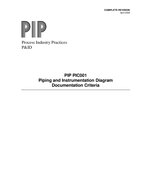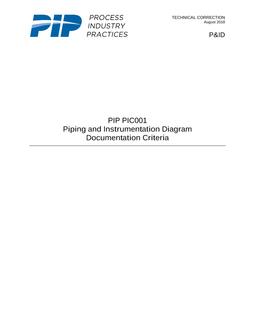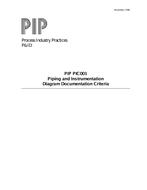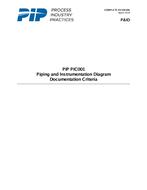Click here to purchase
This Practice provides requirements for designers preparing Piping and Instrumentation Diagrams (P&IDs). This Practice describes the requirements for P&ID format and content. The Practice is independent of time in a facility life cycle and encompasses design, construction, operations, and maintenance.
This Practice covers the generation of new P&IDs and does not apply to the revision of existing P&IDs. This Practice also applies to P&IDs provided by packaged equipment vendors.
This Practice applies to all diagrams that fit the definition of a P&ID in Section 3.
The requirements provided in this Practice can be applied to any CAD system used for developing the P&IDs and are not vendor, hardware, or software specific.
This practice uses U.S. Customary units of measure for drafting dimensions. Line weights are also given in metric units. Current PIP experience is that symbol sizes and drafting dimensions are often based on U.S. Customary units even if the project design and labeling is in metric units. All drafting dimensions could be stated in metric units at the discretion of the user.
The requirements provided in this Practice provide a balance between showing all data on P&IDs and making P&IDs legible and easy to read.
Process specific overlays may be developed to define necessary additional requirements or exceptions.
The example P&IDs included in the Appendixes of this Practice are not intended to recommend specific design details or requirements. Example P&IDs are included to provide an illustration of how the elements of this Practice are combined into a P&ID.
Electronic native files for the text, symbols, and legend sheets are available to PIP Member Companies for input to members? CAD systems. Development of project-specific legend sheets is recommended using the PIP native files as a starting point. Additions and/or deletions are allowed to meet requirements. Legend sheet borders and title blocks can be altered.
Development of P&IDs has historically been led by the petrochemical, oil & gas, and specialty chemical industries. While applicable to all industries, guidelines and practices have primarily focused on these industries. In this revision, we have expanded the scope to include information specific to developing P&IDs for the hygienic processing industries – pharmaceutical, food, and beverage. While Sections 2, 3 and 4 contain requirements for P&IDs across all industries, Appendix D contains content specific to the hygienic processing industry that supplements or replaces that in Sections 2, 3 and 4.
If PIP membership grows to include other industries, it is anticipated that this Practice will expand to have sections on developing P&IDs for the mining, power, pulp and paper, and other industries
Product Details
- Published:
- 08/01/2018
- Number of Pages:
- 62
- File Size:
- 2 files , 1.5 MB



